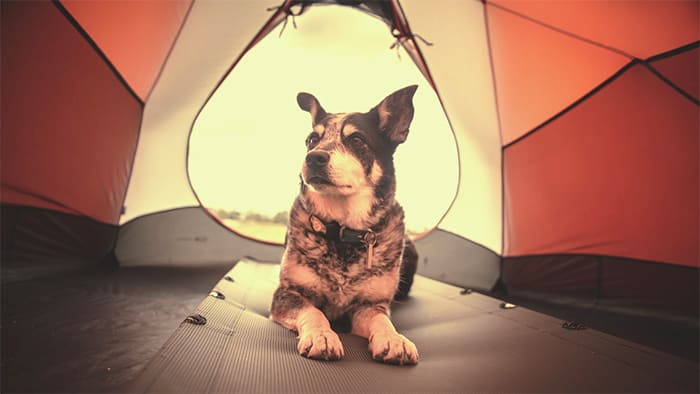Fido is coming along for the camping trip! You just have to make sure you have all the rules down for camping with a dog.
While bringing a dog camping is exciting, dog owners have a responsibility to be safe, courteous, responsible, and lawful when camping with a four-legged one in tow.
The reality is that every camping trip with a dog requires research because dog rules vary by camping location. That could mean that you have to be prepared to adjust your camping rituals site by site if you’ll be trekking to multiple locations during your upcoming camping adventure.
Take a look at everything you need to know about enjoying the great outdoors with man’s best friend in this simple beginner’s guide to camping with a dog.
Planning Your Camping Trip With a Dog: Here’s What You Need to Do to Prepare
Don’t even think about packing the tent in the car until you cover these basics! The truth is that proper planning takes the pain out of camping with a pet. The good news is that your prep checklist for camping with a dog gets a little easier after you do it for that first trip!
Make Sure Your Dog Is Healthy Enough for the Trip
Has it been a while since your dog’s last vet visit? An upcoming camping trip offers the perfect reason to get a routine vet appointment booked.
Making sure that your dog is up to date with all vaccinations before a trip is also important because some campgrounds actually require proof. The reason why is that your dog will be vulnerable to animal attacks that could cause rabies or other transmittable diseases.
A vet visit is also a great time to ask about good methods for flea and tick prevention in highly wooded areas.
Be Honest About What Your Dog Can Handle
You know your dog better than anyone! Even a perfectly healthy, vibrant dog may not be suited for a heavy-duty camping trip requiring long hikes, rugged conditions or extreme weather.
Take into account what your dog likes to do when picking a camping spot that’s compatible. While this is a kind thing do to for your dog, it’s also a smart way to avoid having a miserable time because you’re dealing with an unhappy dog.
Look for Dog-Friendly Camping Locations
It’s not fair to you, your dog or other campers if you try to smuggle your dog into a campsite that isn’t meant for dogs.
There’s some good news. National parks welcome pets on many trails and campgrounds. Many private campgrounds also have pet-friendly sections.
Put in the time to find a campground that welcomes dogs once you’ve narrowed down where you want to camp with a dog for the first time.
Plan a Dog-Friendly Way to Get to Your Destination
Once you know where you’re going, plan to get there using the way that’s best for your dog. Consider a driving route that offers plenty of places to stop for bathroom breaks.
It can be smart to plan a first camping trip a little closer to home if you’ve never taken a road trip with your dog before to help you test how your dog tolerates long drives.
Assembling Your Gear: These Are the Essentials Needed When Camping With a Dog
Dogs need their own camping gear. Your dog is going to be exposed to all of the same elements and conditions as you’ll experience during the trip. Make sure you’re providing your dog with the same levels of comfort and protection that you expect for yourself.
Here’s a quick rundown of the essential gear to pick up for a dog camping trip:
Foldable Bowl and Dish: Get a light, foldable bowl that will go with you everywhere during the camping trip. This will be so important for water and snacks.
Dog Backpack: Consider getting a dog backpack that your dog can wear. This will help you to keep track of your dog’s gear without the fear of accidentally leaving things behind on the trail. Never force your dog to wear a backpack if he clearly doesn’t enjoy it.
Good Harness: Invest in a quality harness if you’ll be hiking during your camping trip. A harness gives your dog more freedom to walk without the need to put a strain on the neck.
Bear-Proof Container: Consider a bear-proof container for storing dog food at your campsite. Those odorous kibbles are hard to hide out in nature.
Glowing Dog Collar: Consider a dog color with an LED light for keeping your eyes on your dog during bathroom breaks in the middle of the night.
Reflective Dog Vest: Consider a reflective vest to keep your dog more visible to other hikers and campers.
Paw Protection: Consider paw coverings to protect your dog’s paws against soreness and chaffing when hiking trails. You can also purchase “pad balms” to keep your dog’s paws soothed.
First-Aid Kit: Dogs can be vulnerable to everything from cuts and scrapes to animal attacks during camping trips. Make sure you’re bringing along a fully stocked medical kit that includes hydrogen peroxide, antibiotic ointment, gauze, tape, scissors, and grooming wipes. Write down the address of an emergency vet in the area where you’ll be camping just in case you can’t get reception on your phone to get the information if you need it.
Dog Bed: Give your dog a comfortable place to sit that’s off the ground.
Dog Sleeping Bag: Consider a zippered dog sleeping bag that allows your dog to “tuck in” warmly without the need for a blanket.
Poop Bags: Bring these everywhere you go! Many campgrounds have strict rules regarding cleaning up after dogs.
Dog Shampoo and Brush: Bring along shampoo and a dog brush just in case your dog gets into something messy.
Dog Rain Jacket: This is a great investment! Your dog will really appreciate a waterproof jacket if things get drizzly out there.
Crate: A crate can be a great thing to take along if you have room because it can provide a comfortable, safe place to isolate your dog if the need arises.
Name Tags: If your dog isn’t already wearing tags, make sure that you have tags made with your contact information.
Kibble Carrier: Purchase a special carrier to hold your dog’s dry food while on the go.
You should also consider bringing along at least one comfort item from home. This can be anything from a favorite toy to a beloved blanket.
Finally, always be sure to pack along any medications or supplements your dog uses on a daily basis.
The Tent: Take Your Dog’s Home Away From Home Seriously
Making sure you have a dog-friendly tent is one of the most important steps to preparing for a camping trip with your dog for the first time. You won’t necessarily need to buy a new tent to camp with your dog. However, it’s important to avoid the assumption that your dog will be happy to sleep anywhere.
If you have a one-person tent, consider upgrading to something that’s suitable for two people if you have a medium-sized or large dog. This can be especially important if your dog isn’t a fan of confined spaces.
You should also take precautions to preserve your tent by putting down sheets or blankets over the floor to prevent clawing. Holes in the bottom of a tent can let cold, moisture, and dirt in.
Finally, give your dog a chance to get familiar with the tent before the big camping trip! You can even set up the tent for a night in your living room to see how your dog reacts. Practice camping can help your dog to feel less anxious when the big night comes!
Establish a Safe, Dog-Friendly Camping Plan
There are some golden rules to follow when camping with a dog! First, avoid keeping food and food debris out at your campsite. It’s critical to be responsible about putting food away because your dog could be in danger if you attract wildlife to your campsite.
While this is important in every camping situation, it’s especially important when you’re camping with your dog because your dog is simply more vulnerable. Your dog might also risk his life trying to defend you.
The second golden rule to camping with a dog is to always clean up after your dog. It may not seem like a big deal to let your dog poop out in nature.
However, the reality is that dog waste can contaminate water and soil. Cleaning up after your dog is just the right thing to do even if nobody can see you.
Finally, be on point with hydration. Don’t let your dog get thirsty out there! A thirsty dog might run to the closest puddle or stream to lap up water. This can put your dog at serious risk for gastrointestinal issues that range from uncomfortable to deadly.
Always have fresh water available for your dog. Consider a portable dog water bottle for the trails if you prefer that over a collapsible dish. Offer water more frequently than you do at home to account for the fact that your dog’s body is working overtime to account for extra activity, extra stress or extreme temperatures.
Go Make Some Memories
Your first time camping with your dog is going to be an extraordinary experience. There’s something really special about watching your dog experience the openness and beauty of nature in such an unrestricted way for the first time.
Of course, this amazing experience demands a great deal of reasonability on your part. Your dog’s comfort, enjoyment and life are honestly in your hands out there. Make sure you’re preparing accordingly.

Fueled by his own lifelong passion for the outdoors, Ryan is dedicated to sharing his knowledge to help others experience the life-changing beauty and majesty of nature. He enjoys planning expeditions throughout the United States. He also has a passion for finding gear and methods that enhance the experience of enjoying nature.
